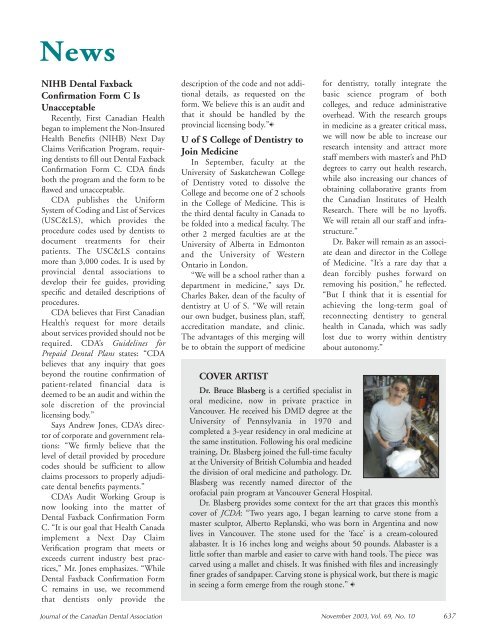JCDA - Canadian Dental Association
JCDA - Canadian Dental Association
JCDA - Canadian Dental Association
Create successful ePaper yourself
Turn your PDF publications into a flip-book with our unique Google optimized e-Paper software.
News<br />
NIHB <strong>Dental</strong> Faxback<br />
Confirmation Form C Is<br />
Unacceptable<br />
Recently, First <strong>Canadian</strong> Health<br />
began to implement the Non-Insured<br />
Health Benefits (NIHB) Next Day<br />
Claims Verification Program, requiring<br />
dentists to fill out <strong>Dental</strong> Faxback<br />
Confirmation Form C. CDA finds<br />
both the program and the form to be<br />
flawed and unacceptable.<br />
CDA publishes the Uniform<br />
System of Coding and List of Services<br />
(USC&LS), which provides the<br />
procedure codes used by dentists to<br />
document treatments for their<br />
patients. The USC&LS contains<br />
more than 3,000 codes. It is used by<br />
provincial dental associations to<br />
develop their fee guides, providing<br />
specific and detailed descriptions of<br />
procedures.<br />
CDA believes that First <strong>Canadian</strong><br />
Health’s request for more details<br />
about services provided should not be<br />
required. CDA’s Guidelines for<br />
Prepaid <strong>Dental</strong> Plans states: “CDA<br />
believes that any inquiry that goes<br />
beyond the routine confirmation of<br />
patient-related financial data is<br />
deemed to be an audit and within the<br />
sole discretion of the provincial<br />
licensing body.”<br />
Says Andrew Jones, CDA’s director<br />
of corporate and government relations:<br />
“We firmly believe that the<br />
level of detail provided by procedure<br />
codes should be sufficient to allow<br />
claims processors to properly adjudicate<br />
dental benefits payments.”<br />
CDA’s Audit Working Group is<br />
now looking into the matter of<br />
<strong>Dental</strong> Faxback Confirmation Form<br />
C. “It is our goal that Health Canada<br />
implement a Next Day Claim<br />
Verification program that meets or<br />
exceeds current industry best practices,”<br />
Mr. Jones emphasizes. “While<br />
<strong>Dental</strong> Faxback Confirmation Form<br />
C remains in use, we recommend<br />
that dentists only provide the<br />
Journal of the <strong>Canadian</strong> <strong>Dental</strong> <strong>Association</strong><br />
description of the code and not additional<br />
details, as requested on the<br />
form. We believe this is an audit and<br />
that it should be handled by the<br />
provincial licensing body.”C<br />
U of S College of Dentistry to<br />
Join Medicine<br />
In September, faculty at the<br />
University of Saskatchewan College<br />
of Dentistry voted to dissolve the<br />
College and become one of 2 schools<br />
in the College of Medicine. This is<br />
the third dental faculty in Canada to<br />
be folded into a medical faculty. The<br />
other 2 merged faculties are at the<br />
University of Alberta in Edmonton<br />
and the University of Western<br />
Ontario in London.<br />
“We will be a school rather than a<br />
department in medicine,” says Dr.<br />
Charles Baker, dean of the faculty of<br />
dentistry at U of S. “We will retain<br />
our own budget, business plan, staff,<br />
accreditation mandate, and clinic.<br />
The advantages of this merging will<br />
be to obtain the support of medicine<br />
for dentistry, totally integrate the<br />
basic science program of both<br />
colleges, and reduce administrative<br />
overhead. With the research groups<br />
in medicine as a greater critical mass,<br />
we will now be able to increase our<br />
research intensity and attract more<br />
staff members with master’s and PhD<br />
degrees to carry out health research,<br />
while also increasing our chances of<br />
obtaining collaborative grants from<br />
the <strong>Canadian</strong> Institutes of Health<br />
Research. There will be no layoffs.<br />
We will retain all our staff and infrastructure.”<br />
Dr. Baker will remain as an associate<br />
dean and director in the College<br />
of Medicine. “It’s a rare day that a<br />
dean forcibly pushes forward on<br />
removing his position,” he reflected.<br />
“But I think that it is essential for<br />
achieving the long-term goal of<br />
reconnecting dentistry to general<br />
health in Canada, which was sadly<br />
lost due to worry within dentistry<br />
about autonomy.”<br />
COVER ARTIST<br />
Dr. Bruce Blasberg is a certified specialist in<br />
oral medicine, now in private practice in<br />
Vancouver. He received his DMD degree at the<br />
University of Pennsylvania in 1970 and<br />
completed a 3-year residency in oral medicine at<br />
the same institution. Following his oral medicine<br />
training, Dr. Blasberg joined the full-time faculty<br />
at the University of British Columbia and headed<br />
the division of oral medicine and pathology. Dr.<br />
Blasberg was recently named director of the<br />
orofacial pain program at Vancouver General Hospital.<br />
Dr. Blasberg provides some context for the art that graces this month’s<br />
cover of <strong>JCDA</strong>: “Two years ago, I began learning to carve stone from a<br />
master sculptor, Alberto Replanski, who was born in Argentina and now<br />
lives in Vancouver. The stone used for the ‘face’ is a cream-coloured<br />
alabaster. It is 16 inches long and weighs about 50 pounds. Alabaster is a<br />
little softer than marble and easier to carve with hand tools. The piece was<br />
carved using a mallet and chisels. It was finished with files and increasingly<br />
finer grades of sandpaper. Carving stone is physical work, but there is magic<br />
in seeing a form emerge from the rough stone.” C<br />
November 2003, Vol. 69, No. 10 637

















